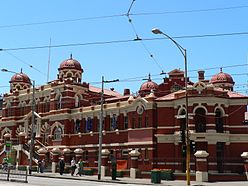- City Baths, Melbourne
-
City Baths 
General information Architectural style Federation Freestyle Town or city Melbourne Country Australia Coordinates 37°48′25″S 144°57′46″E / 37.807038°S 144.962872°ECoordinates: 37°48′25″S 144°57′46″E / 37.807038°S 144.962872°E Construction started 1903 Completed 1903 Design and construction Architect John James Clark City Baths, in Melbourne, Australia, is a historically significant building. Located at 420 Swanston Street, it is of architectural significance.
The Melbourne City Council opened the first Melbourne City Baths on 9 January 1860,[1] which housed public baths. The objective was to stop people from bathing in the Yarra River, which by the 1850s had become quite polluted and the cause of an epidemic of typhoid fever which hit the city resulting in many deaths.[2] However, people continued to swim and drink the water. The Baths were leased to a private operator, but lack of maintenance resulted in such deterioration of the building that the Baths were closed in 1899.
New baths designed by John James Clark were opened on 23 March 1904. Strict separation of men and women was maintained, right down to separate street entrances. Two classes of facilities were maintained, with second class baths in the basement and first class baths on the main floor. Mixed bathing was introduced in 1947 and the popularity of the swimming pool began to increase.[2]
The Baths now house a swimming pool, squash courts and a gymnasium. The swimming pool is divided into four lanes, an Aqua Play lane, a Medium Lane, a Fast Lane and a Slow Lane (or Aquatic Education, when swimming lessons are given) to cater for all types of swimmers. There is also a spa and a sauna.
References
External links
Categories:- Buildings and structures in Melbourne
- Heritage listed buildings in Melbourne
- Federation style architecture
- Romanesque Revival architecture in Australia
- Melbourne stubs
- Australian building and structure stubs
Wikimedia Foundation. 2010.
